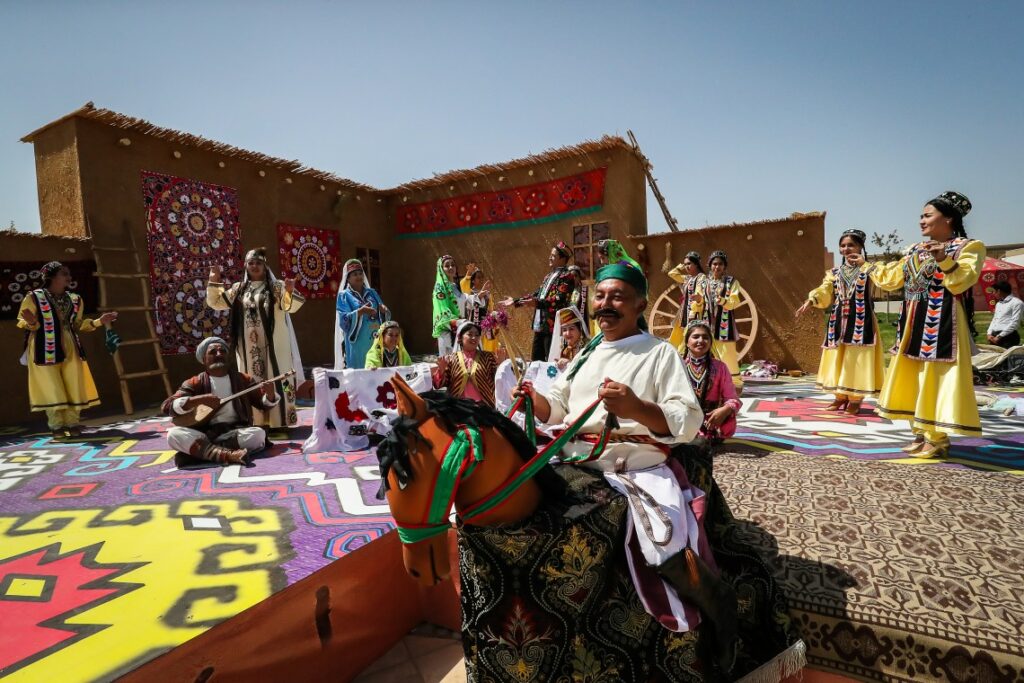CAN JIZZAKH REALLY ENTICE TOURISTS
TO DISCOVER ITS HISTORY AND CULTURE?
Jizzakh lies on the ancient trading road between Tashkent and Samarkand. When you pass this way, the ghosts of historic heroes are beside you: Alexander the Great came here with his armies on campaign, marching between the wealthy cities of Uzbekistan’s Silk Road oases. Amir Timur is remembered here, too, with what is known as Timur Darvaza (Timur’s Gates), a narrow gorge hewn by time and the water of the Sanzar River. Sadly contemporary visitors to Jizzakh tend to be in a rush, driving through the region on their way to Uzbekistan’s more famous tourist destinations. But those who do take the time to get to know Jizzakh are rewarded with rich experiences and long-lasting memories.
It is an easy drive from Samarkand to Jizzakh, but you can also make the journey by train in around an hour. Arriving in the city and looking around you, there is little surviving evidence that Jizzakh was a Silk Road trading post, a place settlement, and strategically valuable enough to warrant the Sogdians, Arabs, and then the Bukhara Khanate building a succession of fortifications. Jizzakh’s main square is named in honour of Sharaf Rashidov, the First Secretary of the Uzbek Communist Party, who was born here in 1917. Rashidov was a poet as well as a politician, and you can learn about his life in the Rashidov Memorial Museum.
The real treasures of Jizzakh are outside the city, however, so think of it as your springboard for adventure. The brightest star in the region’s constellation is the Zaamin National Park, where clean, fresh mountain air fills your lungs and the photogenic landscape is food for the soul. Parts of the national park are at an altitude of 4,200m above sea level and the varied ecosystems support a wealth of native flora and fauna. Such is the fertility of this land, and the lengthy commitment to its conservation, that some of the trees are already 800 years old. There are more than 700 species of plants, 48 of which are endemic. In springtime, Zaamin is a visual feast, as the red tulips and white acacias bloom on the mountainside. You can wander and picnic in the juniper forests, and then as autumn starts to fall, watch as the deciduous trees turn red, orange, and gold, and then finally drop their leaves.

It’s no wonder that nature’s playground has become a centre for the development of ecotourism and adventure tourism, too. For much of the year, the best ways to explore Zaamin National Park are on foot, on horseback, or by mountain bike. It is possible to follow some of the trails alone, but you will get so much more out of the experience if you go with a trained guide. A knowledgeable local person will not only provide good company but also draw your attention to details in the park’s geology, to the bird calls and the footprints, and be able to explain to you these features. Even a short walk can be an education.
In the winter months, deep snow descends on Zaamin. Skiers and snowboarders dust off their salopettes and make the most of the fresh powder. The lift infrastructure is limited for now, but there are future plans for its expansion; and in any case, more experienced skiers and boarders just use existing lifts to access the great expanse of backcountry routes. You could spend days in these mountains and never ski the same slope twice, and frequently you will be the only person around.
There has long been a sanatorium at Zaamin, making the most of the curative properties of the region’s mountain springs. The building’s white sweep of architecture is a stand-out landmark, contrasting with the deep green of the mountain behind. You can stay here for health reasons, of course, but it can also be a comfortable, convenient base for a few days of vacation.
For a contrasting landscape and experiences, go instead to Aydarkul, a manmade lake in the Kyzylkum (Red Desert) in the northern part of Jizzakh Region. Migratory birds, including pink flamingoes, stop here on their long intercontinental flights, so it is a prime site for birding. You can spend a night or two in a yurt camp, inspired by the nomadic lifestyle of generations past, but equipped with modern comforts like a shower block. There is a certain magic to spending a night gathered around a cracking bonfire, flames dancing, as you listen to a talented folk singer. Far from any city light pollution, Aydarkul also has some of the world’s darkest night skies. The quality of star gazing is unmatched, and even with the naked eye you will be able to clearly see the constellations of the northern hemisphere, shooting stars, and even the International Space Station.
Wherever you stay in Jizzakh and for however long, be sure to taste the delicious local cuisine. Many of the dishes are similar to those in other parts of Uzbekistan, but the local samsa have a reputation which rightly extends far beyond the region’s borders. The generous chunks of meat and onion, covered in a crisp, bronzed pastry can easily replace any meal, and a samsa is conveniently portable for a hike, a bike ride, or a picnic beside a picturesque waterfall.
Sophie Ibbotson and Kamila Erkaboyeva
